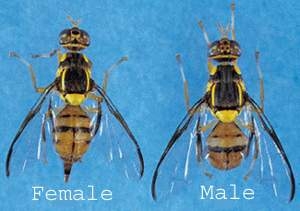California inundated with invasive fruit flies
Bodil Cass
Extension Subtropics Entomologist, Dept of Entomology, UCR
California is experiencing an unusually high number of invasive fruit fly infestations. There are seven active regional quarantines in different areas of the state for four different species of exotic fruit flies in the family Tephritidae: Medfly (Ceratitis capitata) and Tau fly (Zeugodacus tau) in Los Angeles, Queensland fruit fly (Bactrocera tryoni) at the border of Ventura/Los Angeles, and four separate quarantine areas for the Oriental fruit fly (‘OFF'; B. dorsalis) in Riverside/San Bernardino, Contra Costa, Sacramento, and Santa Clara counties. A quarantine just ended following the successful eradication of an infestation of Mexfly (Anastrepha ludens) in San Diego County.
The OFF infestation in San Bernardino/Riverside is especially serious in terms of the unprecedented number of flies found and the many acres of commercial production affected. For this species, six male flies/one mated female/one larva triggers a quarantine, but here we have detected more than 500 adult flies and are still finding more, even during winter. The affected area, including more than 550 square miles, encompasses not just residential properties but an important agricultural region with commercial farms. Farmers in the area are bringing in more trained pesticide applicators, and facing crop losses, delayed harvests, disruption to integrated pest management practices for other pests, and increased costs as they act to mitigate the damage. The unfortunate proximity of the epicenter of the outbreak to agricultural production is necessitating some problem solving and adaptation of mitigation protocols as we race to stop the fly population from establishing.
The quarantine boundary is also approaching the edge of the California Citrus State Historic Park and the University of California Riverside campus, with fly finds less than two miles from active subtropical fruit and biological control research plots, the Givaudan Citrus Variety Collection, and citrus trees of historical importance. Researchers are gauging how the infestation and mitigation protocols might impact current experiments being conducted, including delayed harvest dates, and scrambling to adapt research plans accordingly.
Usually, we have one or two small exotic fruit fly quarantines per year, so the current situation is a strain on resources statewide. The number of areas invested and the severity of the OFF infestation in San Bernardino/Riverside are stretching resources thin as the Department of Agriculture pulls insect detection specialists and staff from other projects to help place more traps, enact compliance agreements, and visit residential properties. San Bernardino County is providing yard signs to help encourage residents not to move produce while the quarantine is in effect.
Exotic fruit flies are one of the most serious threats to food production in the state, with the estimated economic cost of any one of these Tephritidae species becoming established running into the $100 of millions through crop losses, additional pesticide use, and collapse of export markets. These flies are of concern because the larvae/maggots feed on fresh fruit and vegetables prior to harvest. The immature flies chew through the fresh fruit, and it rots on the tree or vine, or drops prematurely to the ground. Fruit infested with large maggots is not marketable to consumers and not fit for human consumption. They are much more damaging than other flies, like smaller Drosophila species that develop on fruit that has already matured, been harvested and is in compost. Tephritidae flies are also highly polyphagous, with some species attacking more than 100 types of fruit, vegetables, and nuts, including the major food crops produced in the state; citrus, avocado, dates, tomatoes, bell peppers, figs, grapes, cucurbits and many specialty crops are all at risk.
We have a long-standing success record of keeping fruit flies out of the state, and fully expect to achieve eradication of all the current infestations through an approach that consists of biological control (mating disruption by sterile insect release), chemical control (targeted pesticide baits), and physical control (destruction of infested fruit from the current season and restrictions on movement of fruit from infested areas). If you have questions about a fruit fly quarantine/eradication, or if you think you have fruits and vegetables infested with fruit fly larvae, call the CDFA Exotic Pest Hotline at 1 (800) 491-1899, contact your local Agricultural Commissioner, or the University's Cooperative Extension. More information specifically for growers is available at regional Farm Bureau meetings and on the CDFA website: https://www.cdfa.ca.gov/plant/PE/InteriorExclusion/current_grower_info.html#INTRO
Image of Oriental Fruit Fly
